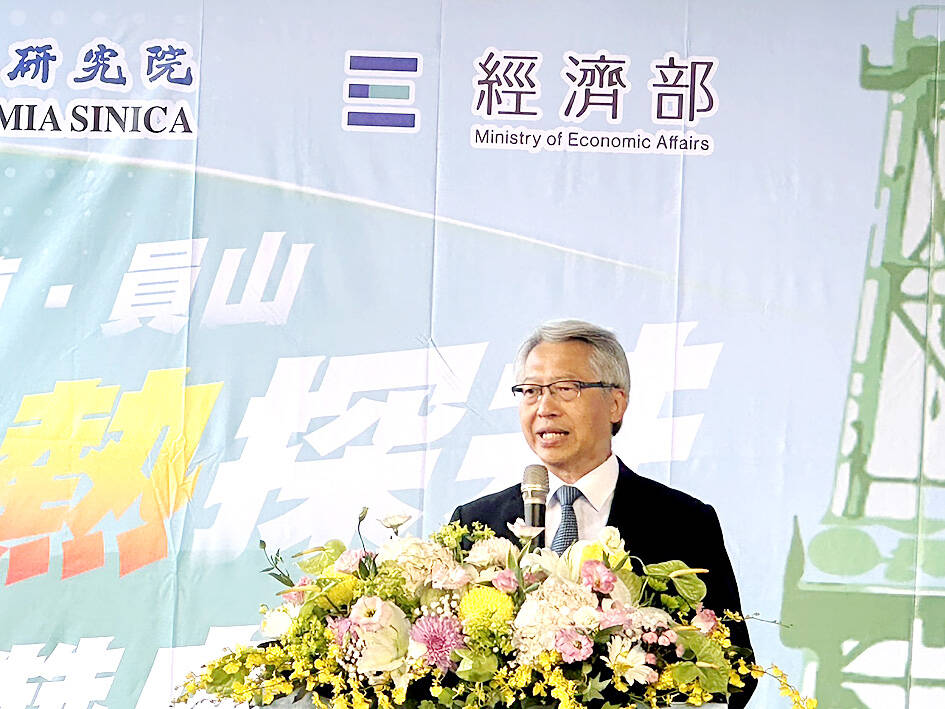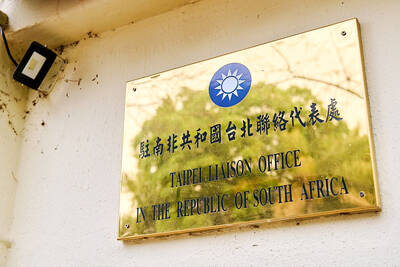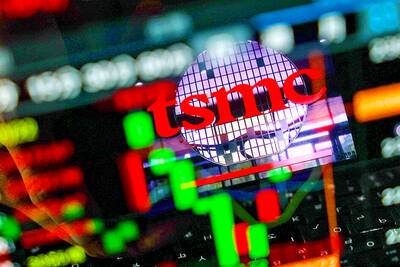Academia Sinica and CPC Corp yesterday began drilling the nation’s first deep geothermal well in Yilan County’s Yuanshan Township (員山).
The 4km-deep well is expected to take 18 months to complete and has an estimated investment of NT$337 million (US$10.54 million), Academia Sinica President James Liao (廖俊智) said.
“While Taiwan has up to 30 gigawatts of potential deep geothermal energy, with an estimated 10 gigawatts being economically viable, only by digging wells can we determine the actual amount of commercially viable geothermal energy,” Liao said at the project’s opening ceremony.

Photo: Yang Yuan-ting, Taipei Times
Data collected during and after the excavation process would be used for future drilling models, helping scientists discover more economically viable heat sources and turn geothermal energy into an important part of clean energy in Taiwan, he said.
To develop and industrialize geothermal energy, relevant laws and regulations need to be updated to entice investors, as current regulations are divided among different government units, Liao said.
Minister of Economic Affairs J.W. Kuo (郭智輝), who also attended the ceremony, said that geothermal resources can be developed into another green energy industry, creating clean energy, job opportunities and promoting local economic prosperity.

Photo: Yang Yuan-ting, Taipei Times
Prior to the start of the drilling yesterday, a research team at Academia Sinica’s Institute of Earth Sciences worked to find potential deep geothermal energy locations, research team member Lee Jian-cheng (李建成) said.
As Taiwan is located in the Pacific Ring of Fire, it is rich in geothermal resources, but “the most challenging task is finding a common location that researchers believe contains geothermal energy,” said another researcher, Huang Hsin-hua (黃信樺).
Using thermal sensing drones to analyze the distribution of heat sources, the research team chose a site on the Lanyang Plain (蘭陽平原) and discovered two sources of deep geothermal energy on either side of the Langyang River (蘭陽溪).
After building 3D models of underground heat sources over two years to pinpoint the geothermal energy locations, they chose to dig the well in Yuanshan County, as the area is more sparsely populated.
While there is confirmed geothermal energy beneath Yuanshan, “there could still be errors of several hundred meters,” Huang said. “Geothermal sources must be physically drilled to verify their existence.”
In the research team’s 3D model, the heat source reached 120°C and started generating energy at 1km to 2km deep, but for the energy to be economically viable, it needs to reach 170°C or more, which requires a depth of at least 4km, Lee said.
While the depth and range of the heat source is still uncertain, it is estimated to be able to generate 20 megawatts (MW) to 30MW of electricity, which is enough to power hundreds of thousands of homes, he said.
Additional reporting by CNA

Taipei, New Taipei City, Keelung and Taoyuan would issue a decision at 8pm on whether to cancel work and school tomorrow due to forecasted heavy rain, Keelung Mayor Hsieh Kuo-liang (謝國樑) said today. Hsieh told reporters that absent some pressing reason, the four northern cities would announce the decision jointly at 8pm. Keelung is expected to receive between 300mm and 490mm of rain in the period from 2pm today through 2pm tomorrow, Central Weather Administration data showed. Keelung City Government regulations stipulate that school and work can be canceled if rain totals in mountainous or low-elevation areas are forecast to exceed 350mm in

EVA Airways president Sun Chia-ming (孫嘉明) and other senior executives yesterday bowed in apology over the death of a flight attendant, saying the company has begun improving its health-reporting, review and work coordination mechanisms. “We promise to handle this matter with the utmost responsibility to ensure safer and healthier working conditions for all EVA Air employees,” Sun said. The flight attendant, a woman surnamed Sun (孫), died on Friday last week of undisclosed causes shortly after returning from a work assignment in Milan, Italy, the airline said. Chinese-language media reported that the woman fell ill working on a Taipei-to-Milan flight on Sept. 22

COUNTERMEASURE: Taiwan was to implement controls for 47 tech products bound for South Africa after the latter downgraded and renamed Taipei’s ‘de facto’ offices The Ministry of Foreign Affairs is still reviewing a new agreement proposed by the South African government last month to regulate the status of reciprocal representative offices, Minister of Foreign Affairs Lin Chia-lung (林佳龍) said yesterday. Asked about the latest developments in a year-long controversy over Taiwan’s de facto representative office in South Africa, Lin during a legislative session said that the ministry was consulting with legal experts on the proposed new agreement. While the new proposal offers Taiwan greater flexibility, the ministry does not find it acceptable, Lin said without elaborating. The ministry is still open to resuming retaliatory measures against South

1.4nm WAFERS: While TSMC is gearing up to expand its overseas production, it would also continue to invest in Taiwan, company chairman and CEO C.C. Wei said Taiwan Semiconductor Manufacturing Co (TSMC) has applied for permission to construct a new plant in the Central Taiwan Science Park (中部科學園區), which it would use for the production of new high-speed wafers, the National Science and Technology Council said yesterday. The council, which supervises three major science parks in Taiwan, confirmed that the Central Taiwan Science Park Bureau had received an application on Friday from TSMC, the world’s largest contract chipmaker, to commence work on the new A14 fab. A14 technology, a 1.4 nanometer (nm) process, is designed to drive artificial intelligence transformation by enabling faster computing and greater power